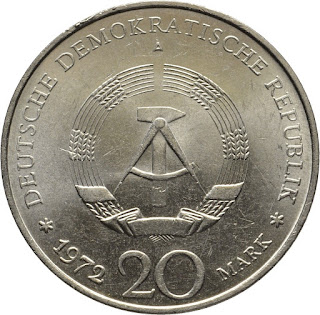German Coins GDR 20 Mark 1972 Wilhelm Pieck
Obverse: The National Emblem of the German Democratic Republic (a hammer and a compass, surrounded by a ring of rye) and the face value of 20 Mark.
Lettering: DEUTSCHE DEMOKRATISCHE REPUBLIK A 1972 20 MARK.
Reverse: Bust of Wilhelm Pieck.
Lettering: · WILHELM PIECK · 1878 - 1960.
Engraver: W. Fitzenreiter, A. Bertram.
Edge: Smooth with inscription.
Lettering: 20 MARK * 20 MARK * 20 MARK * 20 MARK *
Year: 1972.
Value: 20 Mark (20 DDM).
Metal: Copper-nickel.
Weight: 15 g.
Diameter: 33 mm.
Shape: Round.
Wilhelm Pieck
Friedrich Wilhelm Reinhold Pieck (3 January 1876 – 7 September 1960) was a German politician and a Communist. In 1949, he became the first President of the German Democratic Republic, an office abolished upon his death. His successor as head of state was Walter Ulbricht, who served as chairman of the Council of State.
Pieck was born the son of a coachman in the eastern part of Guben, Germany, which is now Gubin, Poland. While he initially trained to become a carpenter, a combination of world events, determined ideology, and political ambition led Pieck to a life of political activism.
As a carpenter, in 1894 Pieck joined the wood-workers' federation, which steered him towards joining the Social Democratic Party of Germany (SPD) the following year. Pieck became the chairman of the party urban district in 1899, and in 1906 became full-time secretary of the SPD. As Bremen Party secretary in 1916, Pieck had asked Anton Pannekoek to continue teaching socialist theory in the party school. Although the majority of the SPD supported the German government in World War I, Pieck was a member of the party's left wing, which opposed the war. Pieck's openness in doing so led to his arrest and detention in a military prison. After being released, Pieck briefly lived in exile in Amsterdam. Upon his return to Berlin in 1918, Pieck joined the newly founded Communist Party of Germany (KPD). On January 16, 1919 Pieck, along with Rosa Luxemburg and Karl Liebknecht were arrested, Liebknecht and Luxemburg were then murdered while "being taken to prison" by a unit of Freikorps. While the two were being murdered, Pieck managed to escape. In 1922, he became a founding member of the International Red Aid, serving first on the executive committee. In May 1925, he became the chairman of the Rote Hilfe.
Following the Nazi Party's takeover in 1933, Pieck went into exile again, first in France, then in Moscow in 1935. In Moscow, Pieck served the Communist Party in a variety of capacities. From 1935 until 1943, he held the position of Secretary of the Communist International. In 1943 Pieck was among the founders of the National Committee for a Free Germany (NKFD). The NKFD planned for the future of Germany after World War II. At the conclusion of the war in 1945 Pieck returned to Germany with the victorious Red Army. A year later, he helped engineer the merger of the eastern branches of the KPD and SPD into the Socialist Unity Party of Germany. He was elected as the merged party's co-chairman, alongside former SPD leader Otto Grotewohl.
In 1949 Pieck was elected president of the GDR. He served as the only president of the GDR until his death in 1960. He lost the chairmanship of the SED in 1950, when Walter Ulbricht became the party's first secretary. Nonetheless, due to Joseph Stalin's trust in him, he retained his other posts.
Pieck lived at Majakowskiring 29, Pankow, East Berlin. His daughter Elly Winter (1898–1987) held various posts in the SED and East German government.

